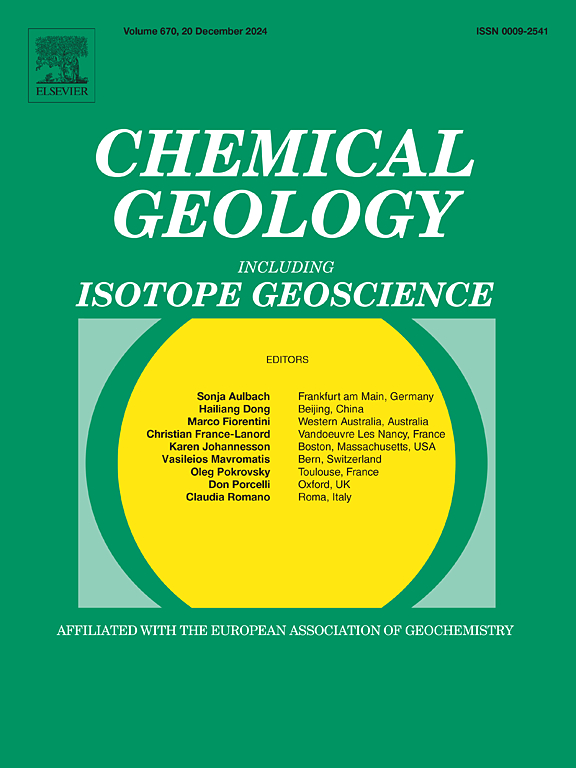Beryllium-isotope signatures in ice sheet proximal marine sediments
IF 3.6
2区 地球科学
Q1 GEOCHEMISTRY & GEOPHYSICS
引用次数: 0
Abstract
Meteoric-10Be has become a popular proxy for assessing glacial environments and processes around Antarctica, such as meltwater discharge or ice shelf environments. Despite applications in recent paleostudies, little testing of the mechanisms driving the deposition of Be-isotopes into marine sediments has been conducted. We used chemical leach procedures to sequentially or partially extract 10Be and 9Be from bulk sediments to assess the possible sources and depositional processes affecting them. Additionally, we leached the reactive phase of five different grainsize splits to determine whether 10Be/9Be ratios normalise for grainsize effects acting upon the 10Be concentration. Reactive Be-isotopes are primarily situated in the oxide phases of sediments, with the amorphous oxide (Am-Ox) phases consisting of much higher 10Be/9Be ratios (∼7–10 × 10−8) than the crystalline oxides (∼1–3 × 10−8; X-Ox), indicating that the Am-Ox phase better represents authigenic oxide production and a circumpolar deep water source, which is contrary to most of the current literature. Published leach procedures targeting the reactive phase of sediment consist of ratios in between the Am-Ox and X-Ox phases (∼3–7 × 10−8), indicating that they target both phases to some degree. The fractionation of Be-isotopes in Antarctic sediment samples shows that circumpolar deep water is the primary source of 10Be, and that the “reactive” signatures from different leach steps targeting the reactive phase are not the same.
冰盖近端海洋沉积物中的铍同位素特征
Meteoric-10Be已成为评估南极洲周围冰川环境和过程的常用代理,例如融水排放或冰架环境。尽管在最近的古研究中有应用,但对be同位素沉积到海洋沉积物中的机制进行的测试很少。我们使用化学浸出程序从大块沉积物中顺序或部分提取10Be和9Be,以评估可能的来源和影响它们的沉积过程。此外,我们还对五种不同粒度的反应相进行了浸出,以确定10Be/9Be的比例是否对10Be浓度对粒度的影响进行了归一化。活性be同位素主要位于沉积物的氧化相中,无定形氧化物(Am-Ox)相的10Be/9Be比率(~ 7-10 × 10−8)远高于结晶氧化物(~ 1-3 × 10−8);X-Ox),表明Am-Ox相更好地代表了自生氧化物的产生和环极深水源,这与目前大多数文献相反。已发表的针对沉积物反应相的浸出程序由Am-Ox和X-Ox相之间的比例组成(~ 3-7 × 10 - 8),表明它们在一定程度上针对这两个相。南极沉积物样品的be同位素分馏表明,环极地深水是10Be的主要来源,并且不同浸出步骤的“反应”特征不相同。
本文章由计算机程序翻译,如有差异,请以英文原文为准。
求助全文
约1分钟内获得全文
求助全文
来源期刊

Chemical Geology
地学-地球化学与地球物理
CiteScore
7.20
自引率
10.30%
发文量
374
审稿时长
3.6 months
期刊介绍:
Chemical Geology is an international journal that publishes original research papers on isotopic and elemental geochemistry, geochronology and cosmochemistry.
The Journal focuses on chemical processes in igneous, metamorphic, and sedimentary petrology, low- and high-temperature aqueous solutions, biogeochemistry, the environment and cosmochemistry.
Papers that are field, experimentally, or computationally based are appropriate if they are of broad international interest. The Journal generally does not publish papers that are primarily of regional or local interest, or which are primarily focused on remediation and applied geochemistry.
The Journal also welcomes innovative papers dealing with significant analytical advances that are of wide interest in the community and extend significantly beyond the scope of what would be included in the methods section of a standard research paper.
 求助内容:
求助内容: 应助结果提醒方式:
应助结果提醒方式:


